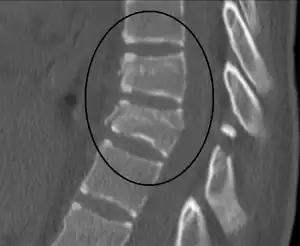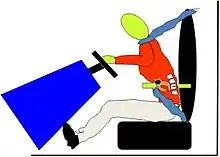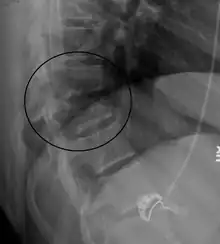Chance fracture
| Chance fracture | |
|---|---|
| Other names: Seatbelt injury,[1] Chance fracture of the spine,[2] flexion distraction fracture,[3] fulcrum fracture of the lumbar spine[4] | |
 | |
| A Chance fracture of T10 and fracture of T9 due to a lapbelt during an MVC. | |
| Specialty | Orthopedics |
| Symptoms | Abdominal bruising, abdominal trauma, neurological symptoms[4] |
| Complications | Splenic rupture, small bowel injury, mesenteric tear[1] |
| Risk factors | Head-on motor vehicle collision in which a person is only wearing a lap belt[1] |
| Diagnostic method | Medical imaging (X-ray, CT scan)[2] |
| Differential diagnosis | Compression fracture, burst fracture[5] |
| Prevention | Shoulder harnesses[4] |
| Treatment | Bracing, surgery[2] |
| Frequency | Rare[6] |
A Chance fracture, sometimes called seat-belt fracture, is a break across the vertebral body frequently associated with abdominal trauma.[1] It is a type of spinal fracture that typically results from a sudden excessive bending forward of the mid-back over a lap belt during a motor vehicle collision (MVC), or from an intense impact to the abdomen following a fall from a height.[1] Symptoms may include seat belt marks and abdominal injuries, or neurological symptoms.[4]
The fracture is typically a result of a head-on vehicle collision, where the sudden slowing of speed causes a lap belt wearing passenger to suddenly be thrown forward over the belt.[1] The hips cannot compensate as they remain held by the belt, and the vertebra becomes pulled apart.[3] Being hit in the abdomen with an object like a tree or a fall may also result in this fracture pattern.[7][8] It often involves disruption of all three columns of the vertebral body.[6] The most common area affected is the lower thoracic and upper lumbar spine.[1] The fracture is generally considered unstable.[1]
Diagnosis is by medical imaging including CT scan.[9] It may be mistaken for a simple compression fracture.[5] Treatment may be conservative with the use of a brace or via surgery.[2]
The fracture is rare.[6] It was more common in the 1950s and 1960s before shoulder harnesses became common.[4][9] Around half of severe abdominal injuries as a result of an MVC have an associated Chance fracture.[10] G. Q. Chance first described the fracture in 1948.[11][12]
Mechanism

In some Chance fractures there is a transverse break through the bony spinous process while in others there is a tear of the supraspinous ligament, ligamentum flavum, interspinous ligament, and posterior longitudinal ligament.[8] In around half of cases there is an associated abdominal injury such as a splenic rupture, small bowel injury, pancreatic injury, or mesenteric tear.[4][9] Injury to the bowel may not be apparent in the first day.[13]
Diagnosis

On plain X-ray a Chance fracture may be suspected if two spinous processes are excessively far apart.[8]
A CT scan of the chest, abdomen, and pelvis is recommended as part of the diagnostic work-up to detect any potential abdominal injuries.[9][8] MRI may also be useful.[8] The fracture is often unstable.[1]
History
It was first described by G. Q. Chance in 1948, in three cases that used a lap belt.[4][12] The fracture was more common in the 1950s and 1960s before shoulder harnesses became common.[4][9]
References
- 1 2 3 4 5 6 7 8 9 Stahel, Philip F.; Weckbach, Sebastian (2022). "20. Spine fractures". In Pape, Hans-Christoph; Jr, Joseph Borrelli; Moore, Ernest E.; Pfeifer, Roman; Stahel, Philip F. (eds.). Textbook of Polytrauma Management: A Multidisciplinary Approach (3rd ed.). Springer. p. 246. ISBN 978-3-030-95906-7. Archived from the original on 2022-09-20. Retrieved 2022-09-17.
- 1 2 3 4 "Wheeless' Textbook of Orthopaedics". Wheeless Online. Archived from the original on 6 July 2018. Retrieved 29 May 2018.
- 1 2 "Fractures of the Thoracic and Lumbar Spine". OrthoInfo - AAOS. Archived from the original on 4 April 2019. Retrieved 29 May 2018.
- 1 2 3 4 5 6 7 8 Yochum, Terry R.; Rowe, Lindsay J. (2004). essentials of skeletal radiology. Lippincott Williams & Wilkins. p. 847. Archived from the original on 2022-09-20. Retrieved 2022-09-18.
- 1 2 Provenzale, James M.; Nelson, Rendon C.; Vinson, Emily N. (2012). Duke Radiology Case Review: Imaging, Differential Diagnosis, and Discussion. Lippincott Williams & Wilkins. p. 247. ISBN 9781451180602. Archived from the original on 2019-12-22. Retrieved 2018-05-29.
- 1 2 3 Marincek, Borut; Dondelinger, Robert F. (2007). Emergency Radiology: Imaging and Intervention. Springer Science & Business Media. p. 152. ISBN 9783540689089. Archived from the original on 2019-12-22. Retrieved 2018-05-29.
- ↑ Hsu, John D.; Michael, John W.; Fisk, John R.; Surgeons, American Academy of Orthopaedic (2008). AAOS Atlas of Orthoses and Assistive Devices. Elsevier Health Sciences. p. 142. ISBN 978-0323039314. Archived from the original on 2020-01-26. Retrieved 2018-05-29.
- 1 2 3 4 5 Pope, Thomas L. (2012). Harris & Harris' Radiology of Emergency Medicine. Lippincott Williams & Wilkins. p. 290. ISBN 9781451107203. Archived from the original on 2019-12-22. Retrieved 2018-05-29.
- 1 2 3 4 5 Patel, Vikas V.; Burger, Evalina; Brown, Courtney W. (2010). Spine Trauma: Surgical Techniques. Springer Science & Business Media. p. 67. ISBN 9783642036941. Archived from the original on 2018-06-12. Retrieved 2018-05-29.
- ↑ Masudi, T; McMahon, HC; Scott, JL; Lockey, AS (2017). "Seat belt-related injuries: A surgical perspective". Journal of Emergencies, Trauma, and Shock. 10 (2): 70–73. doi:10.4103/0974-2700.201590. PMC 5357874. PMID 28367011.
- ↑ Martel, José; Bueno, Angel (2008). "Fractures with names". In Pope, Thomas; Bloem, Hans L.; Beltran, Javier; Morrison, William B.; John, David (eds.). Musculoskeletal Imaging (2nd ed.). Philadelphia: Elsevier. p. 1232.e2. ISBN 978-1-4557-0813-0. Archived from the original on 2022-09-20. Retrieved 2022-09-11.
- 1 2 Chance, GQ (September 1948). "Note on a type of flexion fracture of the spine". The British Journal of Radiology. 21 (249): 452–453. doi:10.1259/0007-1285-21-249-452. PMID 18878306.
- ↑ Hopkins, Richard; Peden, Carol; Gandhi, Sanjay (2009). Radiology for Anaesthesia and Intensive Care. Cambridge University Press. p. 114. ISBN 9781139482486. Archived from the original on 2020-01-26. Retrieved 2018-05-29.
External links
| Classification | |
|---|---|
| External resources |